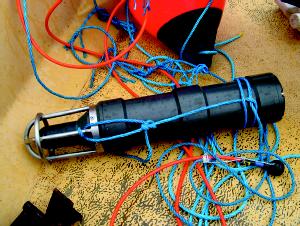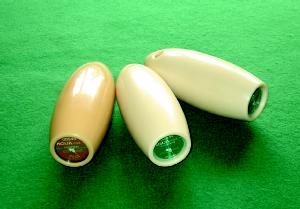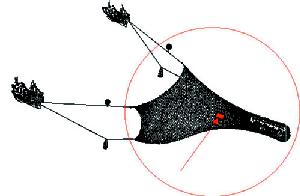| 2002 |

|
YEAR BOOK |
LOUGHBOROUGH UNIVERSITY OF TECHNOLOGY (a) , BORD IASCAIGH MHARA (b) & AQUATEC SUBSEA LTD (c)
|
Describing the development of an experimental
acoustic dolphin deterrent for use on pelagic pair
trawls to study new methods of reducing the
by-catch of small cetaceans
|

Acoustic methods of reducing the bycatch of harbour porpoises, Phocoena phocoena, in bottom set gillnets have now been shown to be very effective, and regulations requiring the use of approved �pingers� in specific areas and fisheries have been introduced in the USA3 and in Denmark 4 , and may now be expected to be applied elsewhere. (Pingers are acoustic deterrent devices.)
The causes of dolphin and other small cetacean bycatch in trawl fisheries appear to be very different from set gillnet captures, and the LU team demonstrated during the EC project CETASEL 5 that dolphins can be attracted to pelagic trawls and can spend significant periods interacting with them. It is believed that some of these animals have learned to enter the nets in order to predate on the fish as they accumulate in the mouth of such nets. The CETASEL study also revealed that these animals do not need to echolocate in order to find the net as the pelagic trawl proved to be a very noisy underwater sound source. Echolocation behaviour was detected when the animals were very close to their prey as analysis of the recorded sonar behaviour predominantly showed very short range inter-click time intervals. Without extensive sonar activity during their approach, it is unlikely that dolphins can acquire a clear image of the trawl net�s structure, and the evidence, from other studies, suggests that they may rely on retracing a �memory mapped� route when exiting the net in order to breath at the surface. The basic cause of multiple animal captures could therefore relate to sudden changes in net geometry which can cause the memorised exit route to be obstructed at a time when the animal may have little or no reserve of air to permit exploration. The age profile of the by-caught animals taken in pelagic trawls suggests this is an adult, knowledge-based, behaviour and quite different from the largely juvenile, 1 to 2 year old age profile, observed in gillnet captures 6 , which suggest a vulnerability due to lack of experience.

As an adjunct to this study, it is intended that trawls of other tuna vessels will be equipped with a small number (4�6) of the AQUAmark100�6 , developed originally for use in gillnet fisheries and the newly developed AQUAmark200� deterrents (Figure 2) with these pingers positioned in a ring around the �sharks teeth� of the trawl. The data reported in EC DGXIV 98/019 (ADEPT)7 and by Imbert 8 suggests that dolphins are repelled to a �safe� distance by these pingers, and that, when grouped together, they should act effectively to keep the animals just outside the hazard zone for typical pair pelagic gear. By using AQUAmark 100s on one trawl and AQUAmark 200s on another, sensible comparisons as to the relative effectiveness of each type of pinger can be made and, through constant monitoring throughout the entire tuna season, comparisons can be made between all three types of pingers.

References
-
BIM 2000 � Diversification trials with alternative tuna fishing
techniques including the use of remote sensing technology.
Final report of EU Contract 98/010, Bord Iascaigh Mhara, Dun
Laoaghaire.
-
Consultancy Report EL/BIM/117 � Loughborough University
Consultants Ltd.
-
NOAA � NMFS Bulletin � Regulations and specification for
pinger used in the sink gillnet fisheries in the Gulf of Maine.
-
Danish Regulations for pingers to be used in the Wreck
net fishery for cod (August 2000).
-
Project DG XIV AIR 3-CT94-2423 CETASEL � Final Report.
-
Project Epic EC DG XIV 97/0006 � Final Report.
-
Project ADEPTs EC DG XIV 98/019 � Final Report.
-
Imbert, G., et al., Prevention a l�aide de repulsivfs acoustiques
des captures de dauphin par les thonailles. 10e Conference
International sur les cetaces Mediterranee de la RIMMO,
Juanles Pins, November 2001.
Contact: Goodson A.D., Loughborough University of
Technology, Loughborough LE 11 3TU, UK; Rihan D.,
Bord Iascaigh Mhara, PO Box 12 Crofton Road, Dun Laoghaire,
Co. Dublin;& Smerdon A., Aquatec Subsea Ltd, Hartley,
Wintney, Hampshire RG27 8NY, UK.